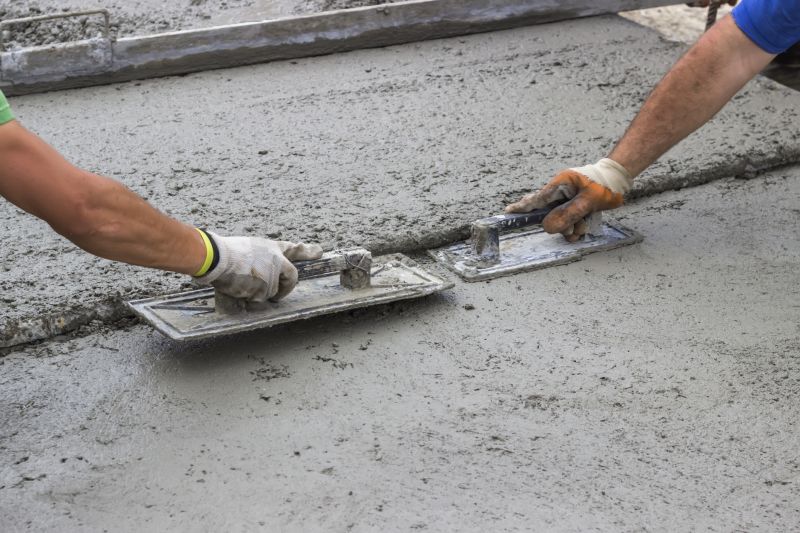Favorite Products For Concrete Crack and Surface Repairs
Identify the most popular options for fixing cracks, chips, and surface imperfections in concrete structures.
 Concrete repair is an essential aspect of maintaining the integrity and safety of various structures, from residential driveways to commercial foundations. Over time, concrete surfaces may develop cracks, surface spalling, or other forms of deterioration due to weather exposure, ground movement, or regular wear and tear. Selecting the right products for concrete repairs can help ensure that repairs are durable and effective, preventing further damage and extending the lifespan of the concrete. When considering repair options, it is important to evaluate the specific type of damage, the location of the repair, and the environmental conditions.
Concrete repair is an essential aspect of maintaining the integrity and safety of various structures, from residential driveways to commercial foundations. Over time, concrete surfaces may develop cracks, surface spalling, or other forms of deterioration due to weather exposure, ground movement, or regular wear and tear. Selecting the right products for concrete repairs can help ensure that repairs are durable and effective, preventing further damage and extending the lifespan of the concrete. When considering repair options, it is important to evaluate the specific type of damage, the location of the repair, and the environmental conditions.
Top Overall Option
Multi-Purpose Concrete Repair Compound
A versatile repair compound suitable for filling cracks, patching surface imperfections, and restoring concrete surfaces. It offers good adhesion, durability, and ease of application, making it a reliable choice for various repair needs. Its compatibility with different concrete types and quick curing time make it a popular option for both DIY enthusiasts and professionals.
Types of Products For Concrete Repairs
Concrete Crack Filler
Designed specifically for filling small to medium cracks, helping prevent further deterioration.
Concrete Patch Mix
Used for repairing larger surface areas and filling pitted or spalled concrete surfaces.
Epoxy Injection Kits
Suitable for structural crack repairs, providing strong bonding and stabilization.
Surface Sealers
Applied over repaired surfaces to protect against moisture penetration and surface damage.
Self-Leveling Underlayment
Ideal for smoothing uneven concrete floors before finishing or overlay applications.
Concrete Resurfacing Products
Used to restore the appearance of worn or damaged concrete surfaces with a new layer.
Polyurethane Foam Sealants
Effective for sealing larger cracks and joints with flexible, durable foam.
Hydraulic Cement
Quick-setting material for sealing active leaks and filling holes in concrete structures.
Bonding Agents
Enhance adhesion between old and new concrete during repairs.
Concrete Repair Mortar
A heavy-duty mortar used for patching large areas or rebuilding damaged sections.
Crack Repair Tape
Reinforces crack repairs and prevents future cracking.
Fiber-Reinforced Repair Products
Contain fibers to improve crack resistance and structural integrity.
Popular Choices
A common choice for sealing small cracks and preventing water infiltration.
Frequently used for patching damaged or spalled concrete surfaces.
Popular for structural crack repairs due to their strong bonding properties.
Selected for protecting repaired surfaces from future damage.
Often used to create smooth, level floors before finishing.
Chosen for restoring worn or faded concrete surfaces.
Valued for quick sealing of active leaks and holes.
Ideal for sealing larger cracks with flexible, durable material.
Commonly used to ensure adhesion between old and new concrete.
Used for rebuilding large damaged sections or structural repairs.
Provides reinforcement for crack repairs and reduces future cracking.
There is a wide range of products available designed to address different types of concrete issues. For small cracks or surface imperfections, patching compounds and crack fillers are commonly used. Larger cracks or structural concerns may require more robust solutions such as epoxy injection kits or concrete resurfacing products. Surface sealers can also play a role in protecting repaired areas from future damage, especially in high-traffic or exposed outdoor environments. Proper preparation and application are key to achieving long-lasting results, so understanding the properties and compatibility of repair products is essential.
In addition to product selection, it is beneficial to consider the ease of use, drying or curing times, and the compatibility with existing concrete surfaces. Some products are formulated for quick repairs, while others may require longer curing periods but offer enhanced bonding strength. For best results, follow manufacturer instructions carefully and consider consulting with a professional if dealing with structural issues or extensive damage. With the right approach and quality products, concrete repairs can restore the appearance and functionality of damaged surfaces effectively.
Key Buying Considerations
- Type of damage: Identify whether cracks, surface spalling, or structural issues are present.
- Repair size: Choose products suitable for small cracks or large surface repairs.
- Curing time: Consider how quickly the product sets and cures to fit your project timeline.
- Bond strength: Ensure the product provides adequate adhesion for long-lasting repairs.
- Environmental resistance: Select products that withstand moisture, freeze-thaw cycles, and temperature variations.
- Ease of application: Look for user-friendly formulas, especially for DIY repairs.
- Compatibility: Verify that the product works well with existing concrete surfaces and finishes.
- Durability: Consider the longevity of the repair, especially in high-traffic or outdoor areas.
- Flexibility: For cracks that may expand or contract, choose flexible repair materials.
- Surface preparation: Be aware of whether the product requires special surface prep or primers.
- Aesthetic finish: Decide if the repair will be visible and if color matching or surface texture is important.
- Cost: Balance quality and budget to select an effective yet affordable product.
- Brand reputation: Opt for products from reputable manufacturers with positive reviews.
- Application environment: Consider indoor vs outdoor use and exposure conditions.
- Regulatory compliance: Ensure the product meets relevant safety and quality standards.
